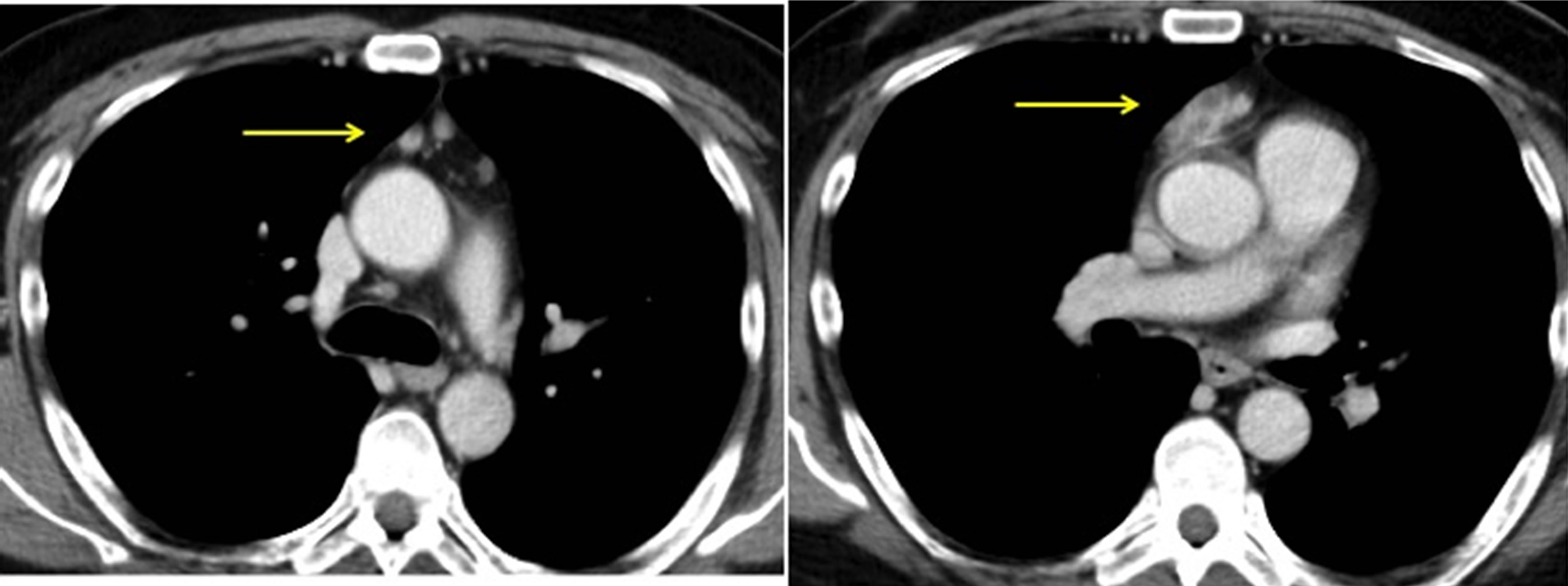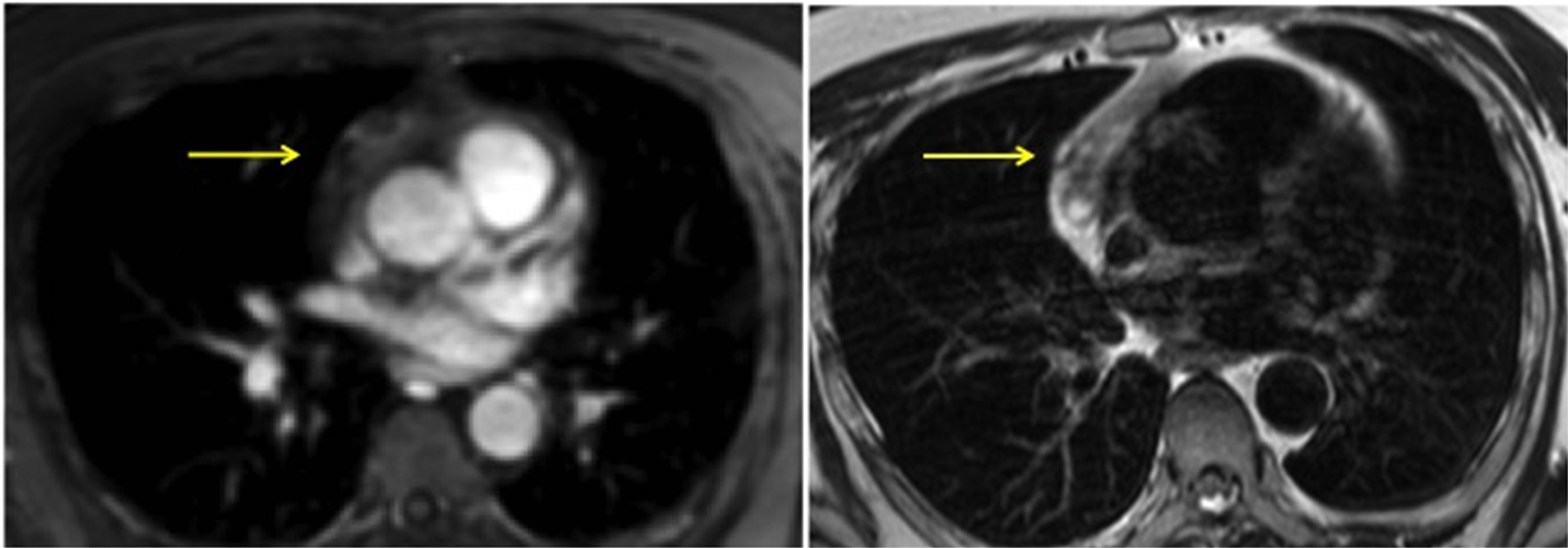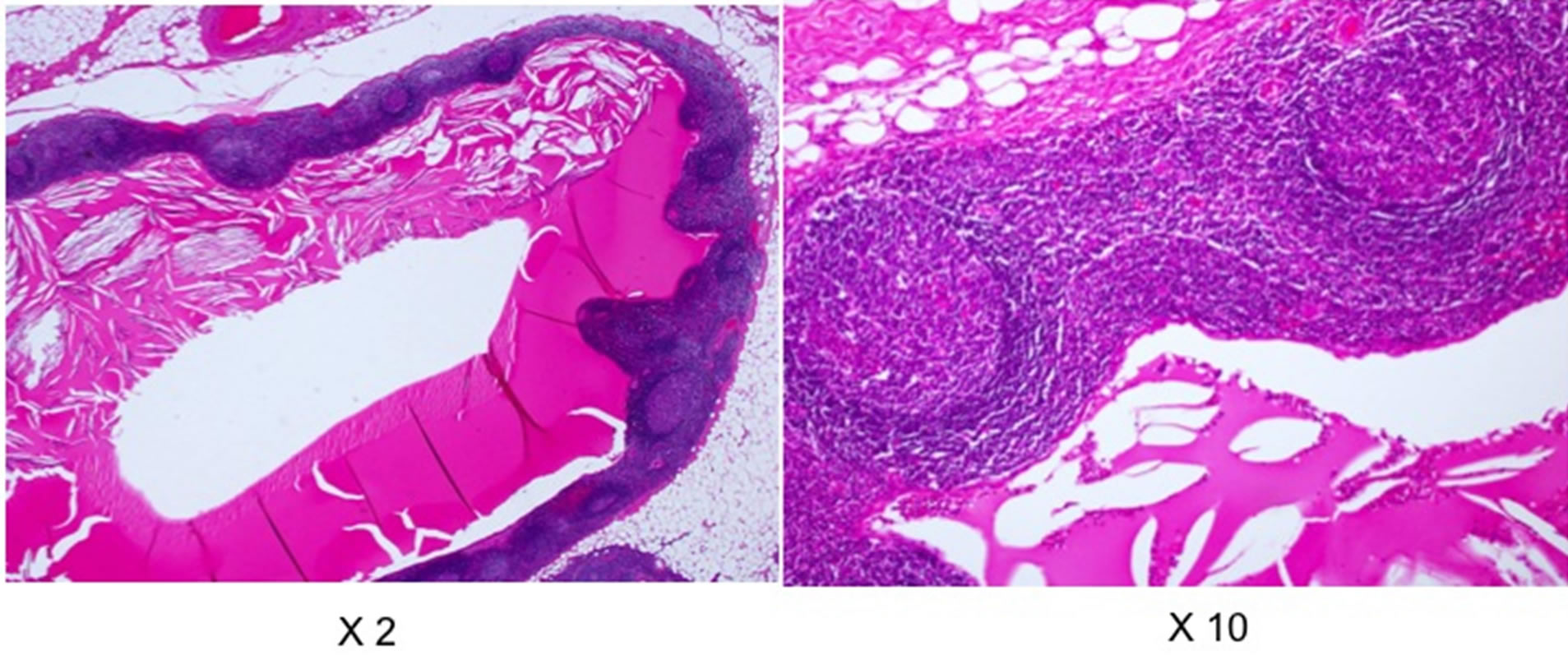Open Journal of Thoracic Surgery
Vol.3 No.4(2013), Article ID:40721,3 pages DOI:10.4236/ojts.2013.34023
Multilocular Thymic Cysts with Follicular Hyperplasia: Report of a Case
![]()
1Department of Chest Surgery, Onga Nakama Medical Association Onga Hospital, Onga-gun, Japan; 2Department of Surgery, Onga Nakama Medical Association Onga Hospital, Onga-gun, Japan; 3Department of Emergency, Onga Nakama Medical Association Onga Hospital, Onga-gun, Japan; 4Second Department of Surgery, University of Occupational and Environmental Health, School of Medicine, Kitakyushu, Japan.
Email: *y-ichiki@med.uoeh-u.ac.jp
Copyright © 2013 Yoshinobu Ichiki et al. This is an open access article distributed under the Creative Commons Attribution License, which permits unrestricted use, distribution, and reproduction in any medium, provided the original work is properly cited. In accordance of the Creative Commons Attribution License all Copyrights © 2013 are reserved for SCIRP and the owner of the intellectual property Yoshinobu Ichiki et al. All Copyright © 2013 are guarded by law and by SCIRP as a guardian.
Received August 17th, 2013; revised September 17th, 2013; accepted September 24th, 2013
Keywords: multilocular thymic cyst; follicular hyperplasia; surgery
ABSTRACT
We herein describe a rare case of multilocular thymic cysts (MTCs) with follicular hyperplasia. The patient was a 50-year-old man, who was symptom-free. A mediastinal mass was found on chest computed tomography (CT) followed after pancreatitis. Chest CT revealed a 30 × 10 mm anterior mediastinal mass with multiple cystic lesions. Magnetic resonance imaging showed an anterior mediastinal cystic mass with low-signal intensity on T1-weighted image and on high-signal intensity T2-weighted image. Thus we made a preoperative diagnosis of MTCs with thymoma within the cyst wall. The lesion was resected by thymectomy. Intraoperatively, multiple cysts and swelling of mediastinal lymph nodes were noted throughout the entire thymus. Histopathological findings revealed lymphoid follicular hyperplasia of thymic tissues but no neoplastic lesions. Based on these findings, a diagnosis of MTCs associated with thymic hyperplasia was made. This is a rare case that preoperatively was difficult to diagnose.
1. Introduction
Benign thymic cysts are rare diseases that account for approximately 1% to 3% of anterior mediastinal masses [1]. Unilocular thymic cysts are usually congenital and are thought to arise from cystic dilatation of bronchial pouch remnants [2], whereas multilocular thymic cysts (MTCs) are considered to be acquired reactive lesions arising within the thymus gland [3]. MTCs are rare and consist of multilocular cysts with thick walls and pericystic fibrous adhesions. Reactive lymphoid hyperplasia with germinal centers is hyperplasia with germinal centers is frequently observed in the cysts of paients with acquired multilocular cysts [3,4], suggesting the involvement of acquired reactive inflammation processes in the development of MTCs [1,3]. We report a case of MTCs with follicular hyper plasia.
2. Case Report
The patient was a 50-year-old man, who was symptom-free. His past history was noncontributory, but family history was notable. A mediastinal mass was found on chest computed tomography (CT) followed after pancreatitis. Chest CT revealed a 30 × 10 mm anterior mediastinal mass with multiple cystic lesions (Figure 1). Magnetic resonance imaging showed an anterior mediastinal cystic mass with low-signal intensity on T1- weighted image and high-signal intensity on T2-weighted image (Figure 2). All of serum carcinoembryonic antigen, alpha-fetoprotein, human chorionic gonadotropin and anti-acetylcholine receptor antibody were not elevated. Thus we made a preoperative diagnosis of a multilocular thymic cyst with thymoma within the cyst wall. The patient was placed in the supine position. Median sternotomy was performed. A videothoracoscope was inserted through the right fourth intercostal space.

Figure 1. A chest computed tomography scan of the patient reveals a 30 × 10 mm anterior mediastinal mass with multiple cystic lesions.

Figure 2. Magnetic resonance imaging showed an anterior mediastinal cystic mass with low-signal intensity on T1- weighted image and high-signal intensity on T2-weighted image.
Intraoperatively, multiple cysts and swelling of mediastinal lymph nodes were noted throughout the entire thymus. Thymectomy was performed and it was completely resected. Macroscopic examination of the thymus revealed multiloculated cavities with fibrous walls of varying thickness and swelling mediastinal lymph nodes. Histopathological findings revealed multiple cystic structures lined by attenuated epithelium with an eosinophilic proteinaceous content, partially undergoing granulomatous changes containing many cholesterin clefts in the thymic tissue with many enlarged lymphoid follicles having prominent germinal centers. There is no evidence of thymoma or malignancy (Figure 3). Based on these findings, a diagnosis of MTCs associated with thymic hyperplasia was made. This is a rare case that preoperatively was difficult to diagnose. The patient had an uneventful postoperative course and was discharged 14 days after the operation.
3. Comment
Mediastinal cysts account for 19% of all mediastinal tumors [5]. Most cystic tumors in the mediastinum are congenital lesions, but the cause of thymic cysts is controversial. Thymic cysts are classified into two types, multilocular and unilocular. The morphological and pathogenetic features of MTCs are different from those of unilocular cysts. Unilocular thymic cysts are either congenital or originate from cystic dilatation of bronchial pouch remnants without inflammatory changes [3]. In contrast, MTCs are acquired lesions induced by an inflammatory process [6].

Figure 3. Histopathological findings revealed multiple cystic structures lined by attenuated epithelium with an eosinophilic proteinaceous content, partially undergoing granulomatous changes containing many cholesterin clefts in the thymic tissue with many enlarged lymphoid follicles having prominent germinal centers. There is no evidence of thymoma or malignancy.
It is important to differentiate a multilocular thymic cyst from a unilocular cyst because it may recur postoperatively and coexist with a thymic epithelial tumor such as thymoma or thymic cancer. Suster and Rosai reported that 2 of 18 patients with multilocular thymic cyst had thymoma and another 2 had thymic carcinoma within the cyst wall [3]. Moreover, recurrence developed in two patients postoperatively, suggesting that incomplete resection may result in recurrent disease. They also reported that four patients had dense adhesions to surrounding structures, making removal of the cyst difficult.
Epitherial cells of the thymus consist of 2 different components, reticular epitherium and medullary duct epithelium derived from endodermal pharyngeal pouch derivatives [7]. It is thought that MTCs were developed by dilatation of medullary duct epithelium-derived structures including Hassall corpuscles [3]. Hassall corpuscles may cause cystic degeneration due to reactive changes secondary to inflammation [8]. The flattened cuboidal epithelia lining the cyst walls might be fragments of degenerative Hassall corpuscles and epithelia connected with Hassall corpuscles.
Nakamura et al. reported that MTCs associated with thymoma accounted for 20 cases (17%) of 110 thymoma cases. Their result suggested that MTCs associated with thymomas are not as uncommon as thought and may develop from the promotion of differentiation of increased numbers of epitherial cells into Hassall corpuscles by inflammatory processes in analysis of twenty patients with MTCs associated with thymoma [9]. They also reported that 30% of the patients with MTCs presented with symptoms associated with inflammation, whereas only 3% of the patients without MTCs showed such symptoms.
Choi et al. analyzed CT examinations of eight patients with MTCs. They revealed that CT cannot be used to reliably distinguish neoplastic from non-neoplastic softtissue components, complete surgical and careful histopathologic examination is recommended in all patients with suspected MTCs [10]. In this case, the patient was symptom free, and it was difficult to determine whether MTCs coexisted thymic epitherial tumor or not, with any examinations except for histological examinations.
In conclusion, when treating MTCs, complete surgical resection should be performed to prevent recurrence. Careful pathological examinations are also essential to exclude coexisting malignancy.
4. Acknowledgements
We would like to thank Professor Masanori Hisaoka and his colleagues of the Department of Pathology and Oncology, School of Medicine, University of Occupational and Environmental Health for their detailed pathological diagnosis.
REFERENCES
- R. J. Mediastinum, “Ackerman’s Surgical Pathology,” 8th Edition, Mosby, New York, 1996.
- P. Zanca, T. H. Chuang, R. De Avila, et al., “True Congenital Mediastinal Thymic Cyst,” Pediatrics, Vol. 36, No. 4, 1965, pp. 615-619.
- S. Suster and J. Rosai, “Multilocular Thymic Cyst: An Acquired Reactive Process Study of 18 Cases,” The American Journal of Surgical Pathology, Vol. 15, No. 4, 1991, pp. 388-398. http://dx.doi.org/10.1097/00000478-199104000-00008
- M. J. Komstein, “Non Neoplastic Pathology of the Thymus,” In: V. A. Livolsi, Ed., Major Problems in Pathology. Pathology of the Thymus and Mediastinum, WB Saunders, Philadelphia, 1995, pp. 34-66.
- A. J. Cohen, L. Thompson, F. H. Edwards and R. F. Bellamy, “Primary Cysts and Tumors of the Mediastinum,” The Annals of Thoracic Surgery, Vol. 51, No. 3, 1991, pp. 378-386. http://dx.doi.org/10.1016/0003-4975(91)90848-K
- Y. Shimosato and K. Mukai, “Tumor of the Mediastinum,” In: J. Rosai, Ed., Atlas of Tumor Pathology, 3rd Series, Fascicle 2, Armed Forces Institute of Pathology Washington DC, 1997, pp. 233-237.
- K. T. Shier, “The Thymus According to Schambacher: Medullary Ducts and Reticular Epithelium of Thymus and Thymomas,” Cancer, Vol. 48, No. 5, 1981, pp. 1183- 1199. http://dx.doi.org/10.1002/1097-0142(19810901)48:5<1183::AID-CNCR2820480524>3.0.CO;2-E
- S. Suster and J. Rosai, “Histology of the Normal Thymus,” The American Journal of Surgical Pathology, Vol. 14, 1990, pp. 284-303. http://dx.doi.org/10.1097/00000478-199003000-00010
- S. Nakamura, H. Tateyama, T. Taniguchi, et al., “Multilocular Thymic Cyst Associated with Thymoma: A Clinicopathologic Study of 20 Cases with an Emphasis on the Pathogenesis of Cyst Formation,” The American Journal of Surgical Pathology, Vol. 36, No. 12, 2012, pp. 1857- 1867. http://dx.doi.org/10.1097/PAS.0b013e31826320c4
- Y. W. Choi, H. P. McAdams, S. C. Jeon, et al., “Idiopathic Multilocular Thymic Cyst: CT Features with Clinical and Histologic Correlation,” AJR, Vol. 177, No. 4, 2001, pp. 881-885. http://dx.doi.org/10.2214/ajr.177.4.1770881
NOTES
*Corresponding author.

